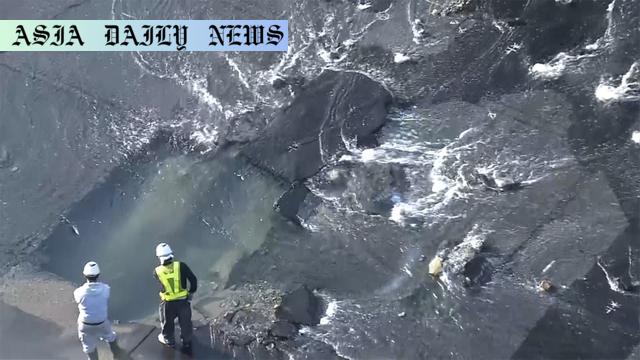Kyoto Water Pipe: Water gushing from a broken pipe inundates highway in Shimogyo Ward, affecting over 6,000 households.
Water from a broken pipe floods Kyoto’s Shimogyo Ward.
Over 6,000 homes may face tap water contamination risks.
Traffic disruptions occur due to inundated highways.
Clean water trucks sent to address resident’s needs.

Aging Infrastructure Leads to Severe Water Leakage
In the early hours of Wednesday morning, a major water pipe burst in Kyoto City, inundating the Takakura intersection in the Shimogyo Ward area. The pipe, measuring 30 centimeters in diameter, gave way at about 3:30 a.m., causing a torrent of water to stretch across a national highway. This burst is currently attributed to the aging infrastructure of Kyoto’s water supply system, an issue that has long required attention due to numerous incidents of wear and tear over the years.
The Kyoto City Water Supply and Sewerage Bureau responded swiftly to the situation. Workers were deployed immediately to work on replacing the broken pipe, as concerns of potential tap water contamination loom over approximately 6,000 buildings and homes in the surrounding area. The bureau reassured residents of their concerted efforts and urged caution, acknowledging the murky water caused by the gushing pipe.
Impact on Residents and Traffic
The water leakage significantly disrupted the lives of many Kyoto residents. With over 6,000 homes potentially at risk of receiving contaminated tap water, the water bureau took proactive measures by dispatching six water supply trucks to provide residents with access to clean drinking water. Local officials continue to monitor the possible expansion of the contaminated area, encouraging citizens to remain vigilant while the repair work is underway.
Meanwhile, the situation also caused significant disruptions to traffic. The flooding of the highway near the Takakura intersection resulted in traffic congestion in the nearby areas. Commuters faced delays and rerouted roads, highlighting the larger infrastructural challenges faced by urban areas such as Kyoto City.
Call to Address Aging Infrastructure
This incident brings to light the importance of addressing aging infrastructure in Japan’s urban hubs, including Kyoto. The burst water pipe serves as a stark reminder of overlooked maintenance issues that pose risks to urban safety, water supply integrity, and daily transportation. City officials have previously noted the need to allocate funding for regular inspection and replacement efforts, but the process has faced challenges due to budget restrictions and competing urban priorities.
To avoid further incidents, cities need to prioritize upgrading and maintaining critical systems, especially water and sewage pipelines, to prevent disruptions that can impact public health and the local economy. For Kyoto’s leaders, this latest event may serve as a defining moment to confront the growing risk posed by deteriorating infrastructure.



Commentary
The Immediate Impact of Kyoto’s Pipe Break
The recent water pipe burst in Kyoto’s Shimogyo Ward is a wake-up call for cities dealing with aging infrastructure. For many residents, the sudden loss of an essential resource like water can disrupt daily lives in profound ways. The immediate response by city officials, such as dispatching water supply trucks, reflects a commendable effort to mitigate the issue. However, the fact that such significant damage has occurred underlines a reactive approach, rather than a preventive strategy by city planners where infrastructure maintenance is concerned.
Challenges in Mitigating Urban Risks
Urban infrastructure in many parts of Japan has been reported to face long-term degradation, yet addressing these issues often falls behind other civic priorities. Budget constraints, logistical challenges, and the sheer scale of citywide systems pose significant barriers to implementing consistent upgrades. Incidents like these highlight the limitations of waiting for catastrophe before prioritizing aging systems and call for a more dynamic, future-oriented approach to urban planning.
Restoring Trust Through Proactive Action
For Kyoto officials, this event presents an opportunity to showcase accountability and forward-thinking action. By committing to transparent reporting on infrastructure conditions and actively engaging the public in discussions about upgrades and restoration works, city leaders could restore trust in public systems while preparing the urban landscape for decades to come. Proactive measures today could prevent similar or even more severe incidents in the future, ensuring the safety and convenience of residents remain paramount.